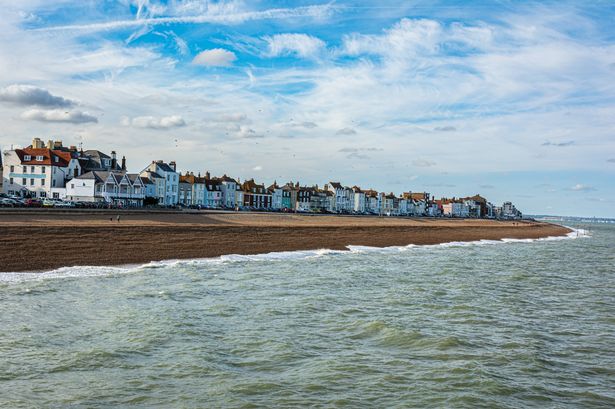I went on a Famous Five-style holiday in the UK

FANCY an adventure holiday that’s straight from the pages of an Enid Blyton, with olden day prices to match?
I stumbled across a secluded Welsh beach only accessible at low tide, overlooked by a former MOD base where families of six can stay for just £7.50 per person – and promptly booked it for my family of five.
Second in Time Out’s list of most underrated European beaches this summer, Skrinkle Haven in Pembrokeshire is cheap as chips to visit.
Family rooms sleeping either four or six at the clifftop hostel starting at just £45 over October half term.
Kids under 10 can eat for £1 at YHA Manorbier with an adult meal, so you could get bed and breakfast overlooking this stunning hideaway haven for just £77 for a family of six.
There’s a self-catering kitchen available to lower meal costs even further if you’re using this as a budget base to explore the Wales Coast Path, which runs in front of the hostel.
A glamping pod for four starts at £40, while camping using your own equipment is £10 per person.
It’s ironic that this beach has remained under the radar, given its past use as a Ministry of Defence site.
The striking hostel exterior remains in keeping with its military roots, while the inside is clean and cosy after a refurb ten years ago.
Clambering down the steep steps from the clifftop to Church Doors Cove, my boys and I were wowed by the incredible rock formation that gives this beach its name.
Most read in Best of British
If you’re looking for something similar to the famous Durdle Door in Dorset, but without another soul in sight, this spot is for you.
The cove is connected to neighbouring Skrinkle Haven beach by a narrow tunnel through the headland, only passable at low tide.
We took a picnic to enjoy on the deserted golden sands of the bay before exploring caves that would be perfect for smugglers to stash their loot.
It really was like stepping into the pages of an Enid Blyton story, with a crumbling stairway no longer in use at one end of the beach and the narrow tunnel that fills with water at high tide at the other.
Time and tide wait for no man and if you’re cut off by the rising waters, you’ll be stranded here until the next low tide.
Walking three and a half hours east on the coastal path, you’ll find the gorgeous town of Tenby, with its colourful houses and beautiful beaches.
Keep the Famous Five vibe alive by visiting St Catherine’s Fort perched on a rocky outcrop on the beach or taking a boat trip to Caldey Island, home to Cistercian monks and a colony of puffins.
There’s a neolithic burial chamber known as King’s Quoit along the Pembrokeshire coastal path west of the hostel, so you’re surrounded by spots straight out of a Secret Seven story whichever direction you take as you step out of the front door.
If you’re not a fan of hostels and want to stay somewhere a bit more upmarket, there’s some great family options in easy reach of Skrinkle Haven.
Haven’s Kiln Park is just a 10-minute drive away, with caravans sleeping six starting at £129 during October halfterm, while a three-bed lodge is £670.
It’s got its own Blue Flag beach on the doorstep and lots of kids activities, including sessions with a nature ranger.
For luxe lodgings, try Bluestone Resort, within a half hour drive.
Bluestone is the Welsh answer to Center Parcs and has lodges starting at £760 over halfterm.
There’s a huge indoor soft play, outdoor activities and an amphitheatre under the glass Serendome and the Blue Lagoon water park, all included in the price.
We loved our meal at Camp Smokey, a hideaway hut down in a wooded valley that offers alfresco meals and family fun.
So why not give a Welsh staycay a go this October half term?
With secluded beaches, coastal walks and plenty of places to stay, you’ll be spoilt for choice for channelling your inner Enid Blyton.
Trump’s AI poop post caps a week of MAGA indifference to Hitler jokes
An estimated 7 million Americans turned out Saturday to peacefully protest against the breakdown of our checks-and-balances democracy into a Trump-driven autocracy, rife with grift but light on civil rights.
Trump’s response? An AI video of himself wearing a crown inside a fighter plane, dumping what appears to be feces on these very protesters. In a later interview, he called participants of the “No Kings” events “whacked out” and “not representative of this country.”
I’m beginning to fear he’s right. What if the majority of Americans really do believe this sort of behavior by our president, or by anyone really, is acceptable? Even funny? A recent Economist/YouGov poll found that 81% of Republicans approve of the way Trump is handling his job. Seriously, the vast majority of Republicans are just fine with Trump’s policies and behavior.
According to MAGA, non-MAGA people are just too uptight these days.
Vice Troll JD Vance has become a relentless force for not just defending the most base and cruel of behaviors, but celebrating them. House Speaker Mike Johnson has made the spineless, limp justification of these behaviors an art form.
Between the two approaches to groveling to Trump’s ego and mendacity is everything you need to know about the future of the Republican Party. It will stop at nothing to debase and dehumanize any opposition — openly acknowledging that it dreams of burying in excrement even those who peacefully object.
Not even singer Kenny Loggins is safe. His “Top Gun” hit “Danger Zone” was used in the video. When he objected with a statement of unity, saying, “Too many people are trying to tear us apart, and we need to find new ways to come together. We’re all Americans, and we’re all patriotic. There is no ‘us and them’,” the White House responded with … a dismissive meme, clearly the new norm when responding to critics.
It may seem obvious, and even old news that this administration lacks accountability. But the use of memes and AI videos as communication, devoid of truth or consequence, adds a new level of danger to the disconnect.
These non-replies not only remove reality from the equation, but remove the need for an actual response — creating a ruling class that does not feel any obligation to explain or defend its actions to the ruled.
Politico published a story last week detailing the racist, misogynistic and hate-filled back-and-forth of an official, party-sanctioned “young Republican” group. Since most of our current politicians are part of the gerontocracy, that young is relative — these are adults, in their 20s and 30s — and they are considered the next generation of party leaders, in a party that has already skewed so far right that it defends secret police.
Here’s a sample.
Bobby Walker, the former vice chair of the New York State Young Republicans, called rape “epic,” according to Politico.
Another member of the chat called Black Americans “watermelon people.”
“Great. I love Hitler,” wrote another when told delegates would vote for the most far-right candidate.
There was also gas chamber “humor” in there and one straight up, “I’m ready to watch people burn now,” from a woman in the conversation, Anne KayKaty, New York’s Young Republican’s national committee member, according to the Hill.
Group members engaged in slurs against South Asians, another popular target of the far right these days. There’s an entire vein of racism devoted to the idea that Indians smell bad, in case you were unaware.
Speaking of a woman mistakenly believed to be South Asian, one group member — Vermont state Sen. Samuel Douglass, wrote: “She just didn’t bathe often.”
While some in the Republican party have denounced, albeit half-heartedly, the comments, others, including Vance, have gone on the attack. Vance, whose wife is Indian, claims everyone is making a big deal out of nothing.
“But the reality is that kids do stupid things. Especially young boys, they tell edgy, offensive jokes. Like, that’s what kids do,” Vance said. “And I really don’t want us to grow up in a country where a kid telling a stupid joke — telling a very offensive, stupid joke — is cause to ruin their lives.”
Not to be outdone, Johnson responded to the poop jet video by somehow insinuating there is an elevated meaning to it.
“The president was using social media to make a point,” Johnson said, calling it “satire.”
Satire is meant to embarrass and humiliate, to call out through humor the indefensible. I’ll buy the first part of that. Trump meant to embarrass and humiliate. But protesting, of course, is anything but indefensible and the use of feces as a weapon is a way of degrading those “No Kings” participants so that Trump doesn’t have to answer to their anger — no different than degrading Black people and women in that group chat.
Those 7 million Americans who demonstrated on Saturday simply do not matter to Trump, or to Republicans. Not their healthcare, not their ability to pay the bills, not their worry that a country they love is turning in to one where their leader literally illustrates that he can defecate on them.
But not everyone can be king.
While the young Republicans believe they shared in their leader’s immunity, it turns out they don’t. That Vermont state senator? He resigned after the Republican governor put on pressure.
Maybe 7 million Americans angry at Trump can’t convince him to change his ways, but enough outraged Vermont voters can make change in their corner of the country.
Which is why the one thing Trump does fear is the midterms, when voters get to shape our own little corners of America — and by extension, whether Trump gets to keep using his throne.
West Ham: ‘We are relegation candidates’, says fan after defeat by Brentford
These are troubling times for West Ham off the pitch too.
There were a large number of empty seats at London Stadium on Monday as some fans staged a boycott, staying away in protest against the running of the club.
While this was the first boycott, supporters have previously called for chairman David Sullivan and vice-chair Karren Brady, who have been at West Ham since 2010, to step down.
Thousands of fans demonstrated before last month’s defeat by Crystal Palace and in response the club issued a lengthy statement,, external saying they were continuing “to listen to fan feedback”, have made “significant investment into the football operation” and “continue to do everything we can to improve the matchday experience”.
Payne was one of the fans who stayed away from the game for what he said was the first and the last time he will do so.
“There was a boycott but fans are not the problem, we are the solution waiting to be heard,” he said.
“It was a deliberate boycott to send a message to the owners that something has got to change.”
Payne said fan protests are solely aimed at the club’s owners, rather than the manager or players.
But Nuno’s decision to start with inverted full-backs against Brentford did raise some eyebrows.
“It’s unfair on Nuno and it’s unfair on the players as well,” Payne added.
“Nuno is a fantastic bloke, but I think he got his selections a bit skew-whiff last night by playing a young left-back – who has never played anywhere else – as right-back. Ollie Scarles, I felt sorry for him really.”
Slovak court sentences poet that shot PM to 21 years for ‘terror attack’ | Gun Violence News
The populist government has blamed the 2024 attack on ‘hatred’ spread by opposition and critical media.
A Slovak court has convicted the pensioner who shot Prime Minister Robert Fico last year of a “terror attack” and sentenced him to 21 years in prison.
The Specialised Criminal Court in Banska Bystrica convicted and sentenced 72-year-old Juraj Cintula on Tuesday, saying he had acted “with a motivation to stop a proper functioning of the government” in a “particularly serious” crime.
Cintula, a poet from Levice in western Slovakia, shot Fico four times at close range on May 15, 2024 as the premier left a government meeting in central Slovakia.
He later claimed he was driven by “moral despair”. Fico was left seriously wounded but returned to work two months later.
The shooting and subsequent trial have shaken the small NATO-member country.
Now serving his fourth term as prime minister, Fico has repeatedly accused the liberal opposition and media of fuelling the assassination attempt, without presenting evidence.
Prosecutors originally charged Cintula with premeditated murder, but they later reclassified the shooting as a “terror attack”, citing his political motivation.
Critics have said that since the shooting, the populist Fico has become increasingly divisive, accelerating his alignment of Slovakia’s foreign policy with Russia, increasing criticism of the European Union, and implementing authoritarian and hardline conservative policy.
‘Most likely appeal’
“It was worth it,” local media quoted Cintula as shouting as he left court earlier this month after giving his closing trial statement.
After the shooting, Cintula had told police he wanted to protest against steps taken by Fico’s government, including the halting of military aid to war-ravaged Ukraine, according to a leaked video.
He claimed he had sought to hurt, but not kill, the prime minister.
In his final trial statement, a visibly emotional Cintula told the court he had been overcome with “moral despair”, accusing the prime minister of being “drunk with power” and making “irrational decisions that damage this country”.
He called his defence “a manifesto … for all those who feel that the arrogance of power, corruption and lies has no place in the country where our children will grow up”.
“The premier … embodied years of accumulated frustration and despair,” Cintula said.
Cintula’s lawyer, Namir Alyasry, told reporters after the hearing that he would “most likely appeal” the verdict.

The prime minister was not present at the trial and did not immediately comment on the verdict.
He previously said he forgave the attacker, whom he described as merely a “messenger of evil and political hatred” developed by the “politically unsuccessful and frustrated opposition”.
Since his return to office in 2023, Fico’s government has launched a crackdown on nonprofit organisations, cultural institutions and some media outlets it deems “hostile”, prompting mass protests.
Fico has also angered the opposition by calling for an end to Slovakia’s support for Ukraine, criticising EU sanctions targeting Russia and saying he would not allow Ukraine to join NATO.
Last month, the Slovak parliament approved a constitutional amendment to limit the rights of same-sex couples as part of a sweeping change that also states that national law takes precedence over EU law.
US-Australia Rare Earths Deal Marks a Start, But China’s Grip Will Endure
The recent agreement between the United States and Australia to invest $3 billion in critical minerals and rare earths projects represents a significant step in the Western effort to reduce dependency on China for strategically vital resources.
While the deal has been heralded by Washington as a turning point in global supply diversification, a closer examination suggests that China’s entrenched dominance in rare earth mining, refining, and magnet manufacturing will remain largely unchallenged in the foreseeable future.
This analysis situates the agreement within the broader geopolitical and economic context of resource security, outlines its potential and limitations, and assesses its implications for the evolving balance of power in the Indo-Pacific region.
Rare Earths and Strategic Dependence
Rare earth elements (REEs) are indispensable for modern technology spanning clean energy, defence systems, electric vehicles, and semiconductors. Despite their name, REEs are relatively abundant in the Earth’s crust; their scarcity lies in the technically complex, costly, and environmentally damaging refining process.
Over the past three decades, China has systematically consolidated control over this value chain, developing low-cost refining and magnet production capabilities that now underpin 90% of global processing capacity, 69% of mining, and 98% of magnet manufacturing (Goldman Sachs, 2024).
This dominance has translated into a form of strategic leverage. Beijing has repeatedly demonstrated its ability to weaponize resource supply chains, most recently through export curbs on gallium, graphite, and rare earth magnets, heightening Western concerns about supply security and industrial resilience.
The United States and its allies, including Japan, Australia, and the European Union, have consequently prioritized critical mineral diversification as a matter of both economic sovereignty and national security.
Key Issues:
Technological Dependence:
Western economies lack refining and magnet manufacturing infrastructure comparable to China’s mature ecosystem, which benefits from decades of state investment and technological standardization.
Environmental and Regulatory Constraints:
High environmental standards, community opposition, and lengthy approval timelines in the U.S. and Australia increase project costs and delay production, deterring private investment.
Market Distortion by State Subsidies:
Chinese producers benefit from state-backed financing, subsidized energy, and vertically integrated industrial networks that suppress global prices, making it difficult for Western firms to compete without government intervention.
Investor and Consumer Behavior:
Global manufacturers continue to prioritize low-cost Chinese supply, perpetuating dependency despite policy rhetoric about diversification.
Geopolitical Fragmentation:
Efforts to “de-risk” supply chains are hindered by divergent national strategies among Western allies, with varying levels of commitment to resource security versus environmental and economic priorities.
The U.S.-Australia Critical Minerals Pact
On October 20, 2025, President Donald Trump announced a joint U.S.-Australia agreement committing $3 billion to the exploration, mining, and processing of critical minerals.
The pact includes provisions for a price floor a mechanism designed to ensure profitability for Western miners operating in markets distorted by Chinese state subsidies and environmental cost advantages.
According to the White House, U.S. investments will “unlock deposits worth over $53 billion” in Australian reserves. The U.S. Export-Import Bank (EXIM) has issued seven Letters of Interest totaling $2.2 billion to Australian mining firms, including Arafura Rare Earths, developer of the Nolans project in Western Australia.
While these measures indicate a serious financial commitment, they also highlight the industrial asymmetry between emerging Western projects and China’s mature, vertically integrated supply chains.
Economic Feasibility and Industry Timelines
Industry experts have expressed caution regarding the feasibility of rapid supply diversification.
Barrenjoey analyst Dan Morgan noted that the “time frame for various projects to be ready even by 2027 would be heroic,” reflecting the inherent capital intensity and regulatory delays in rare earth development.
Similarly, Dylan Kelly of Terra Capital observed that the current pricing of NdPr oxide the most traded rare earth compound “does not reflect a market dynamic that can sustain a significant fall in prices,” implying that a price floor mechanism may be essential for commercial viability.
Such perspectives underline the structural constraint that industrial policy cannot compress geological and technological timelines. New rare earth projects require multi-year investments in exploration, environmental clearance, and processing technology transfer.
Strategic and Geopolitical Dimensions
The U.S.-Australia pact is emblematic of a broader strategic realignment in the Indo-Pacific, wherein critical minerals are increasingly framed not merely as commodities but as strategic enablers of power projection.
For Washington, the deal aligns with its economic security agenda to “de-risk” supply chains and reduce China’s capacity to use resource dependencies as geopolitical tools.
For Canberra, it represents both an economic opportunity and a strategic burden. Australia possesses abundant mineral reserves but faces pressure to align its export policies with U.S. strategic interests, potentially straining its trade relations with China still its largest trading partner.
At a deeper level, the agreement signals the emergence of a critical minerals bloc, mirroring patterns seen in energy geopolitics. Yet, the absence of comparable refining infrastructure, skilled labor pools, and environmental cost advantages continues to limit Western competitiveness.
Market Reactions and Corporate Beneficiaries
The deal has already produced identifiable commercial winners.
Arafura Rare Earths and Syrah Resources have reported increased investor interest following the announcement, reflecting market confidence in Western government-backed financing.
Arafura’s CFO, Peter Sherrington, emphasized that the U.S.-Australia initiative “de-risks raising money from an equity perspective,” while its CEO projected full project funding by early 2026.
However, as Syrah CEO Shaun Verner noted, unless global consumers “cure their addiction to lowest-cost supply from China,” even well-financed Western projects will struggle to secure stable demand. This underscores a behavioral dimension of market dependency, wherein private-sector procurement patterns perpetuate Chinese dominance despite political rhetoric of diversification.
Implications for Global Resource Governance
In the short term, the U.S.-Australia agreement is unlikely to materially alter the global rare earth landscape.
China’s entrenched advantages in scale, technology, and regulatory flexibility will ensure continued dominance through the decade.
Nevertheless, the pact marks an important symbolic and structural step toward building alternative supply chains, particularly if accompanied by coordinated policies on processing technology, environmental standards, and market access.
In the medium to long term, such agreements could catalyze a Western-led industrial ecosystem, reducing strategic vulnerability and fostering innovation in cleaner extraction methods. However, success will depend on sustained political will, technological breakthroughs, and a willingness to absorb short-term economic inefficiencies for long-term security gains.
Analysis: Strategic Patience Over Political Rhetoric
The U.S.-Australia rare earths pact represents a strategically coherent but operationally constrained response to China’s resource hegemony. It reflects the increasing securitization of economic policy in an era of great-power competition.
Yet, as this analysis indicates, the pathway to rare earth independence will be long, capital-intensive, and geopolitically fraught.
While the agreement sends a strong signal of Western resolve, the transformation of intent into industrial capability will take years, not electoral cycles.
Until then, China’s dominance will persist not simply because of its mineral reserves, but due to its unparalleled integration of industrial policy, technological expertise, and geopolitical strategy.
With information from Reuters.
I live in a charming seaside town brimming with independent shops that comes alive in autumn
I moved to Kent during the pandemic and am yet to leave. From its bustling high street to its sandy beaches, there’s something for everyone in this charming seaside town
Five years ago, I relocated to Deal in Kent during lockdown, intending to flee the deserted streets and sky-high rent of London, with plans to return once normality resumed. Needless to say, that didn’t transpire, and here I am, half a decade later.
Despite my occasional grumbles about the town, I’m not too proud to confess that I’ve become smitten with the place. There’s nothing quite like strolling down a bustling high street brimming with independent shops, cafes, restaurants and pubs on a Saturday morning.
One of my favourite activities is indulging in a slice of cake on a Saturday afternoon after hours spent hunting for Christmas and birthday gifts for my loved ones. While the summer months are undoubtedly warmer and the town buzzes with more activity, Deal truly shines in the autumn.
Christmas lights begin to twinkle, illuminating the charming high street on damp, grey afternoons; shop windows burst into life with festive displays, and the aroma of freshly baked pastries and hearty pub meals permeates the air.
The experience is also more tranquil overall. I often find myself steering clear of Deal High Street and the seafront during the summer, when they’re teeming with tourists queuing for ice cream, precariously balancing pints of beer in plastic cups, or fishing off Deal Pier.
While it can be off-putting, I’m pleased it’s bustling. Without these summer visitors, many local businesses would struggle throughout the rest of the year, reports the Express.
The charm of Deal lies in its fantastic independent shops and cafes. While you’ll find a few essential chains like Superdrug, Boots, Costa and Starbucks at one end of the high street, the majority of the town’s shops are independent businesses.
One of my favourite spots is Barkened, a small independent shop at the North end of the high street. It’s brimming with carefully selected items that make perfect gifts for dog-lovers and homeware enthusiasts.
For those in search of unique gifts and eclectic clothing, Urban Chic is your destination. The shop is full of colourful womenswear, sunglasses, gifts, cards, bags and homeware. It’s my go-to place for Christmas gifts as I’m always sure to find something unique that can’t be found elsewhere.
Tucked away down St George’s Passage just off the high street, The Little Purple Wardrobe is a true hidden treasure filled with pre-loved designer and high street women’s clothes, shoes, hats and accessories.
It’s always my first stop when I’m hunting for an outfit for a special occasion or simply in need of some quality clothing.
Just off the high street on the corner of Stanhope Road, visitors will discover a truly unique shop: Pop! Vintage and Retro.
Overflowing with vintage and retro items, vinyl records, enamel signs, collectables, furniture and more, it’s the ideal stop if you’re searching for a gift for that eccentric uncle or the friend who has everything.
Every Saturday morning, from 9am to 2pm, the Union Road car park at the north end of the high street transforms into a bustling weekly market. During these hours, the high street’s northern end is pedestrianised, creating a vibrant atmosphere as locals and visitors alike peruse the wide array of goods on offer. The market boasts an impressive variety of stalls, selling everything from fresh flowers and vintage clothing to books, furniture, arts and crafts, and mouth-watering cakes.
Even if you’re not in the mood for shopping, it’s a delightful way to spend a Saturday morning, perhaps with a coffee in hand from Real Deal Roasters. I often find myself picking up freshly cut flowers and eggs, which are both cheaper and superior to their supermarket counterparts.
Lately, I’ve set myself the challenge of sampling all of Deal’s eateries—a daunting task given their sheer number.
A few weeks back, on a whim, I popped into Little Harriettes of Deal Tea Rooms for some warm scones and a pot of tea. The experience was utterly charming, and the entire lunch—which included homemade soup with bread, two pots of tea, and two large warm scones with jam and clotted cream—cost less than £20.
The staff were incredibly attentive and friendly, instantly making me feel comfortable. The decor was exactly what you’d expect from a traditional Victorian tea room: a small chandelier, an old-fashioned till, vintage furniture, a cake counter, and tea served in floral bone china.
If you’re not a fan of tea and cakes, there’s a wide range of savoury options on the menu, including vegetable tarts, sandwiches and soup.
Just last week, I popped into Miretti, situated at the North end of the high street. I confess, I’ve been strolling past this cafe for years, always promising myself that I’d stop by one day.
On a crisp autumn afternoon, I finally kept that promise and dropped in for a slice of cake and a decaf coffee.
This cosy cafe is run by a welcoming couple and offers a small selection of homemade cakes, chocolates and Italian biscuits, alongside illy coffee and hot chocolate. Although the selection is limited, the coffee and food items I sampled were divine. I indulged in a small dark chocolate praline truffle that was rich, nutty and luxurious, and a set vanilla custard cake that was creamy and just the right amount of sweet.
Sat at a table on the pavement, it was delightful to sip my coffee and nibble on my cake while watching the world pass by.
Miretti has now earned a solid spot on my list of must-visit locations on Deal High Street.
With its abundance of trendy eateries and foodie destinations, it’s tough to single out the best pubs and restaurants in Deal.
Last year, esteemed food critic Grace Dent hailed the Japanese-inspired eatery Blue Pelican, nestled on Beach Street, as one of her top restaurants of the year. In contrast, a few years back, Jay Rayner lauded The Rose on Deal High Street for its “impressive cooking”. I’ve yet to sample the fare at either establishment, but the feedback I’ve received from both tourists and locals has been nothing short of stellar.
For a scrumptious dinner with a beachfront view, my personal favourite is 81 Beach Street, a cosy bistro known for its superb steak and seafood dishes that won’t break the bank.
I’d also suggest giving The Boathouse Bar & Restaurant a try, which is part of The Royal Hotel situated on the seafront. During the balmy months, you can snag a table outside and watch the waves crash against the shingles on the beach below.
Come autumn, you’ll likely prefer to dine indoors to escape the chilly winds, but you’ll still be treated to a splendid view of the sea.
For breakfast, I always point people towards Goose on the Green and The Corner Cafe in Walmer, and The Lane in South Court, just off Deal High Street. Each of these spots offers a slightly different menu, but they all share a common thread—friendly, attentive staff and high-quality ingredients at fair prices.
After a leisurely Sunday stroll along the pier and back, I’d strongly recommend heading over to The Ship Inn on Middle Street.
This traditional pub, complete with rickety wooden chairs, candles on tables and friendly staff who’ll happily stop for a chat, is a real gem. During the winter months, a roaring fire fills the establishment with a warm glow and a pleasant smoky scent that always reminds me of autumn. It’s also one of the few places where you can still get a pint for less than £4.
Living in Deal is fantastic. There’s always something happening, and there’s never a shortage of great food spots.
Comic Donna Preston is on board for good value trains from Scotland to London with a Railcard – plus top city stops

©News Group Newspapers Limited in England No. 679215 Registered office: 1 London Bridge Street, London, SE1 9GF. “The Sun”, “Sun”, “Sun Online” are registered trademarks or trade names of News Group Newspapers Limited. This service is provided on News Group Newspapers’ Limited’s Standard Terms and Conditions in accordance with our Privacy & Cookie Policy. To inquire about a licence to reproduce material, visit our Syndication site. View our online Press Pack. For other inquiries, Contact Us. To see all content on The Sun, please use the Site Map. The Sun website is regulated by the Independent Press Standards Organisation (IPSO)
Our journalists strive for accuracy but on occasion we make mistakes. For further details of our complaints policy and to make a complaint please click this link: thesun.co.uk/editorial-complaints/
Harper Lee’s ‘Land of Sweet Forever’ review: Collection adds to legacy
Book Review
The Land of Sweet Forever
By Harper Lee
Harper: 224 pages, $30
If you buy books linked on our site, The Times may earn a commission from Bookshop.org, whose fees support independent bookstores.Book Review
Fortunately for avid bibliophiles, Harper Lee was an inveterate pack rat. Born in rural Monroeville, Ala., in 1926, the author of “To Kill a Mockingbird” — whose first name is Nelle, her grandmother Ellen’s name spelled backward — spent much of her adult life in Manhattan after moving there in 1949.
First, she lived in a cold-water flat on the Upper East Side (subsisting on peanut butter sandwiches and meager bookstore and airline ticket agent salaries); then in a room in a Midtown hotel where Edith Wharton and Mark Twain once resided; a third-floor York Avenue walk-up ($20 a month for five years, where “Go Set a Watchman” and “To Kill a Mockingbird” were written); and, finally four decades at 433 E. 82nd St. There, amid “piles of her correspondence and practically every pay stub, telephone bill and canceled check ever issued to her, were notebooks and manuscripts” and eight previously unpublished early short stories and eight once-published essays and magazine articles. Those writings, discovered in her New York City apartment after she died in her Alabama hometown nine years ago, have been gathered into the welcome hybrid compendium “The Land of Sweet Forever.”

The short stories take up the first half of the collection, but it’s an unusual selection in the second half, “Essays and Miscellaneous Pieces,” that may reveal as much about the burgeoning author as the fictional juvenilia. In a contribution to “The Artists’ & Writers’ Cookbook” (1961), along with entries by Lillian Hellman, William Styron and Marianne Moore, Lee offered a one-page recipe for crackling bread, complete with the authorial observation, “some historians say by which alone fell the Confederacy.” The opening instruction is, “First, catch your pig.” After that, the ingredients (water-ground white meal, salt, baking powder, egg, milk) and directions might just as well function as an analogy for the process of writing and editing a manuscript.
In her introduction, Lee’s appointed biographer Casey Cep observes that it “takes enormous patience and unerring instincts to refine a scrap of story into something … keen and moving.” Lee admits to being “more of a rewriter than a writer.” In a 1950 letter to one of her sisters, she outlines her typical writing day, working through at least three drafts:
From around noon, work on the first draft. By dinnertime, I’ve usually put my idea down. I then stop for a sandwich or a full meal, depending on whether I’ve got to think more about the story or just finish it. After dinner, I work on a second draft, which involves sometimes tearing the story up and putting it together again in an entirely different way, or just keeping at it until everything is like I want it. Then I retype it on white paper, conforming to rules of manuscript preparation, and run out & mail it. That sounds simple, but sometimes I have worked through the night on one; usually I end up around two or three in the morning.
It’s all rather like testing, perfecting a recipe. If the product was these eight short stories, then “yes, chef” has baked a perfect loaf.
Each story illuminates Lee’s quintessential talents as the “balladeer of small-town culture” and the chronicler of city life. They display narrative skills, an acute ear for dialogue (especially the vernacular), development of fully rounded characters and vivid descriptions of settings. They also introduce subjects and significant themes — family, friendship, moral compass — that reappear in her nonfiction and novels.
Country life imposes restrictions on childhood characters in the first three stories. In “The Water Tank” anxious 12-year-old Abby Henderson, reacting to schoolyard rumors, believes she’s pregnant because she hugged a boy whose pants were unbuttoned. Anti-authoritarian first grader Dody (one of Harper’s nicknames) in “The Binoculars” is chastised for not tracing but writing her name on the blackboard. Early glimpses of “Mockingbird’s” Scout and Atticus Finch appear in the amusing “The Pinking Shears” when third grader “little Jean Louie” (without the later “s”) undermines gender rules when she whacks off a rambunctious minister’s daughter’s lengthy locks.
In New York City, where “sooner or later you meet everybody you ever knew on Fifth Avenue,” urban stress leads to a shocking monologue with an incendiary conclusion about feuding neighbors in “A Roomful of Kibble,” a frivolous kind of parlor game involving movie titles in “The Viewer and the Viewed,” and a humorous parking incident when one friend agrees to help another with lighting for a fashion show in “This Is Show Business?”
The closing title short story, “The Land of Sweet Forever,” adeptly merges locations and themes. It opens with a satirical nod to Jane Austen’s “Pride and Prejudice”: “It is a truth generally acknowledged by the citizens of Maycomb, Ala., that a single woman in possession of little else but a good knowledge of English social history must be in want of someone to talk to.” When adult Jean Louise (now with the “s”) leaves the city for home, she has a hilarious church encounter with someone she hadn’t seen since they were children, 21-year-old Talbert Wade, now with the taint of three years as an economics major at Northwestern University and a patina full of Europe, looking “suspiciously as if he had returned from a tour and had picked up a Brooks Brothers suit on the way home.” Together, they are trying to understand why the doxology, always sung “in one way and one way only” suddenly has been “pepped up” with an energetic organ accompaniment. Before it’s resolved there is an amusing anecdote about a cow obituary in verse and a concluding bow to Voltaire’s “Candide” when Jean Louise concedes that “all things happen for the best in this, the best of all possible worlds.” The story is a resounding example of Lee’s scintillating sense of wry humor.
Big themes of love, family and friendship recur in the eight previously published essays and articles (from 1961 to 2006) that appeared in Vogue, McCall’s, an American Film Institute program (about Gregory Peck), a Book of the Month Club newsletter (on the “little boy next door” Truman Capote and “In Cold Blood”), Alabama History and Heritage Festival, and O, the Oprah Magazine (a letter about the joy of learning to read). In addition to the crackling bread recipe that serves as a fingerpost to Lee’s writing process, the standout essay “Christmas to Me” details how she received a generous gift that changed her life, allowing her to become an accomplished, published writer. In 1956, best friends, lyricist-composer Michael Brown and his wife, Joy, surprised her with an envelope on the tree with a note, “You have one year off from your job to write whatever you please. Merry Christmas.” That meant $100 every month, covering more than five times her rent.
Juvenilia is tricky. It can be evanescent, exposing weaknesses or revealing strengths and talent. “The Land of Sweet Forever” reinforces Lee’s indelible voice, contributing a rewarding addition and resource to the slim canon of her literary legacy.
The recipe for crackling bread:
First, catch your pig. Then ship it to the abattoir nearest you. Bake what they send back. Remove the solid fat and throw the rest away. Fry fat, drain off liquid grease, and combine the residue (called “cracklings”) with:
1 ½ cups water-ground white meal
1 teaspoon salt
1 teaspoon baking powder
1 egg
1 cup milk
Bake in very hot oven until brown (about 15 minutes).
Result: one pan crackling bread serving 6. Total cost: about $250, depending upon size of pig. Some historians say by this recipe alone fell the Confederacy.
Papinchak, a former English professor, is a freelance book critic in Los Angeles. He has also contributed interviews to Bon Appetit.
Kenny Loggins slams Donald Trump for using his ‘Top Gun’ song ‘Danger Zone’ in AI feces video
Published on
21/10/2025 – 9:22 GMT+2

ADVERTISEMENT
Kenny Loggins has reacted to Donald Trump using his song ‘Danger Zone’ in the president’s “disgusting” AI-generated video showing himself wearing a crown, flying a “KING TRUMP” fighter jet and bombing a crowd of protesters with feces.
The video was published as a response to the historic “No Kings” protests which took place across the US on Saturday.
The American singer-songwriter recorded the hit song for the soundtrack of the 1986 Tom Cruise movie Top Gun. He has now called for Trump’s video to be taken down on copyright grounds.
In a statement to Variety, Loggins said: “This is an unauthorized use of my performance of ‘Danger Zone.’ Nobody asked me for my permission, which I would have denied, and I request that my recording on this video is removed immediately.”
He continued: “I can’t imagine why anybody would want their music used or associated with something created with the sole purpose of dividing us. Too many people are trying to tear us apart, and we need to find new ways to come together.”
“We’re all Americans, and we’re all patriotic. There is no ‘us and them’ — that’s not who we are, nor is it what we should be. It’s all of us. We’re in this together, and it is my hope that we can embrace music as a way of celebrating and uniting each and every one of us.”
Well put – especially considering the video has provoked widespread outrage online, with many expressing dismay over the way it shows Trump’s clear disdain for people exercising their right to protest.
Social media users accused Trump of having “the maturity and decorum of a 12-year-old boy”, while others commented: “Can’t believe that’s a president of a country.”
Many posts also pointed out that Trump’s “childish” and “disgusting” AI post revealed a transparent representation of his genuine feelings toward the American people. “It tells you everything you need to know about what he thinks about the people of America who are, in fact, America,” one person commented, while another added: “Him taking a dump on the country is the most honest thing he’s ever posted.”
This is far from the first time that Trump and his administration have used artists’ work without authorisation.
There is an extensive list of musicians who have objected to Trump’s authorized use of their songs. These include ABBA, The Rolling Stones, Bruce Springsteen, Rihanna, Neil Young, R.E.M., Woodkid, Beyoncé and Semisonic.
Sinead O’Connor’s estate previously issued Trump with cease-and-desist orders, while Isaac Hayes’ estate sued him for 134 counts of copywright infringement.
Céline Dion also condemned the use of her song from the Oscar-winning film Titanic, ‘My Heart Will Go On’, which was used at one of Trump’s rallies. Dion’s team questioned the song choice, writing: “And really, THAT song?”
Another band which added their name to the ever-growing list of artists who have sued Trump over the illegal use of their songs in campaign videos was The White Stripes. Last year, the rock band highlighted the “flagrant misappropriation” of their hit song ‘Seven Nation Army’. Jack White captioned a copy of the legal complaint in an Instagram post with: “This machine sues fascists.”
The most recent example to date is Metallica, who forced the US government to withdraw a social media video that used their song ‘Enter Sandman’ without authorisation.
This weekend’s “No Kings” protests saw millions of Americans marching against Trump’s administration, opposing the president’s “authoritarian power grab.”
The 18 October protest, the third mass mobilisation since Trump’s return to the White House, drew nearly 7 million people across all 50 states according to organisers. This figure would make it the largest single-day mobilisation against a US president in modern history.
Brand new £160m UK train station to open in days as all fares are revealed

THE opening date for a massive £160 million train station servicing London is just days away – and all destinations and ticket fares have finally been revealed.
It is the first new station on the East Coast line for 100 years, and will be a massive boost for thousands of commuters.

As previously reported, Beaulieu Park Station in Chelmsford is being built in the north of the city and is part of a huge regeneration project in the area.
It will provide frequent trains to-and-from London Liverpool Street in just 40 minutes and opens on Sunday, October 26, 2025.
The mega station will have three platforms, a new track for passing, faster trains, plus a taxi rank, drop-off areas and bus connections.
There will also be more than 750 parking spaces for people to leave their vehicles while using the trains.
Parking charges start from £3.50 for an hour rising to £11.50 for the day.
London Liverpool Street connects over 100 million people annually and is one of the UK’s busiest stations.
An off-peak day return from Beaulieu Park Station to London Liverpool Street is priced at £28.20, while seven-day season tickets will cost £134.60.
A day return to London Liverpool Street during peak hours will cost travellers £42.60.
For those travelling to and from Stratford, the costs are £22.60 for an off-peak ticket, £19.70 for a standard day single and £35.30 for a standard day return.
The new service will also service Southend Airport, with tickets costing £16.90 for a standard day single, £24.10 for a standard day return, and £21.30 for a child day return.
Residents of other cities such as Ipswich and Norwich will also benefit from Beaulieu Park Station.
The full list of fares and services is available from operator Greater Anglia.
Major upgrade
The new station is part of a major upgrade to the city.
This includes the construction of new roads and up to 14,000 new homes.
Of these, more than 4,000 homes have received planning permission so far, with 2,000 of those already built.
The project has been years in the making.
The original planning permission was granted in 2013.
Work has been ongoing since 2023 with the opening date finally on the horizon.
Chelmsford has a huge commuter rail service that sees over 15,000 passengers every day and 5.7 million annual users.
The development of Beaulieu Park has also been put in place to try and relieve congestion in the city centre.
The new north-eastern bypass will make access to the new station from surrounding towns such as Braintree much easier.
There’s A New Train Operator In Town …

They hope to challenge Eurostar with trips across the Channel…
A brand-new train operator is hoping to launch services between the UK and Europe, offering ‘competitive fares’ for passengers.
Currently, Eurostar is the only rail operator that connects the UK to destinations across Europe, including cities in France, Belgium and the Netherlands.
This could all change as a new train operating company, Gemini,has announced its plans to launch services between the UK and Europe.
The new train operator, which is currently being established, hopes to begin its rail journey by launching services from London to Paris and Brussels.
Once services between London and Paris/Brussels have launched, Gemini hopes to further its list of European destinations.
The new rail operator plans to introduce ‘new cutting-edge trains and a fresh approach to sales and ticketing’ on services between the UK and Europe.
L.A. City Council candidate to be fined $17,500 for ethics violation
After 12 years on the Los Angeles City Council, Curren Price will be term-limited out of the legislative body this coming year.
The candidate he hopes will replace him comes from his staff, his deputy chief of staff, Jose Ugarte, who has been referred to in the past as Price’s “right-hand man.”
But with many months to go before ballots are cast, Ugarte is already in hot water with the city’s Ethics Commission.
According to documents released by the commission, Ugarte has agreed to pay a $17,500 fine for repeatedly failing to disclose outside income he made from his lobbying and consulting firm while also working as a council staffer.
A commission investigation found that Ugarte failed to report outside income from his consulting firm, Ugarte & Associates, for the years 2021, 2022 and 2023, according to the documents.
The Ugarte proposed settlement is set to go before the Ethics Commission on Wednesday.
“This was an unintentional clerical reporting error on my part. As soon as I was made aware, I took full responsibility and corrected them,” Ugarte said in a statement emailed to The Times. “I take disclosure seriously. Moving forward, I have implemented steps to ensure nothing is missed.”
Ugarte said his work with Ugarte & Associates never overlapped with his time in Price’s office. He started working for Price in 2013, but left the office in 2019. He returned in 2021. Ugarte & Associates was formed in 2018 and still conducts business. He co-owns the company with his sister.
The settlement comes as Ugarte’s boss faces his own ethics quandary.
Price was indicted two years ago on 10 counts of grand theft by embezzlement after his wife’s consulting firm received payments of more than $150,000 between 2019 and 2021 from developers before Price voted to approve projects.
Prosecutors also said Price failed to list his wife’s income on his ethics disclosure forms.
Prosecutors have since filed additional charges against Price saying his wife, Del Richardson, was paid hundreds of thousands by the city housing authority while Price voted in favor of millions in grants to the agency. He also wrote a motion to give $30 million to the L.A. County Metropolitan Transportation Authority from 2020 to 2021, a time frame in which Richardson was paid more than $200,000 by the agency.
Price said he supports Ugarte despite the ethics violation.
“This matter dates back to 2021, when he was not employed by the city, and is clerical in nature,” Price said in a statement texted to The Times. “I wholeheartedly support Jose Ugarte, alongside an unprecedented coalition of elected officials, labor groups, and community leaders who stand behind his character, leadership and proven record of results.”
Ugarte is one of the leading candidates running to represent Council District 9, which covers South Los Angeles. He raised $211,206 in the first reporting cycle of the election, far outpacing his rivals.
One of Ugarte’s opponents, Estuardo Mazariegos, called the Ethics Commission findings “very disturbing.”
The Ethics Commission also alleged that Ugarte’s documents about outside income, known as Form 700s, failed to report clients who gave $10,000 or more to Ugarte & Associates.
Those clients were mostly independent expenditures for local candidates.
His firm was paid $128,050 to help with the reelection campaign of Congressman Jimmy Gomez (D-California). It was also paid $222,000 by Elect California to help with the reelection campaign of Mitch O’Farrell among other clients.
“This proposed settlement raises more questions than it answers: Are these the only payments Ugarte hid? Why was he concealing them from the public? And above all, how did these massive payments in outside interests affect Jose Ugarte’s work as a city employee?” Mazariegos said in a statement to The Times.
9 concerns Dodgers should have about facing Blue Jays in 2025 World Series
The Blue Jays’ bullpen, frankly, has not been very good in this postseason. Entering Monday’s Game 7, the group had a 6.02 ERA and only one successful save.
In that Game 7, however, the Blue Jays showed the ability that still resides in that group.
Louis Varland, a right-hander acquired at the trade deadline, recorded four outs while giving up just one run, and has a 3.27 ERA in the playoffs. Seranthony Domínguez, another right-handed deadline acquisition, pitched a scoreless inning to lower his October ERA to 4.05.
Toronto used a couple starters from there, getting scoreless innings from Gausman and fellow veteran Chris Bassitt.
But at the end, the final three outs belonged to veteran right-hander Jeff Hoffman, a 2024 All-Star who had a disappointing debut season after signing in Toronto this offseason, but now has both of their postseason saves.
The Blue Jays’ one big bullpen weakness is its lack of dominant left-handed depth. Mason Fluharty has been their best southpaw, but has a 6.23 ERA in the playoffs. Brendon Little, Eric Lauer and ex-Dodger Justin Bruihl are also on their roster, but haven’t been any more effective.
112 exhibits and counting — a woman pursues the Smithsonian treasures

Kathryn Jones visits the National Museum of Natural History (L and R) and the National Museum of Asian Art (C), both part of the Smithsonian complex in Washington, D.C. Photos by Kathryn Jones
WASHINGTON, Oct. 21 (UPI) — When Kathryn Jones began to visit Washington’s museums in January, she didn’t plan to make it her full-time pursuit. But after 112 exhibits and hundreds of hours spent inside the Smithsonian’s galleries, she discovered the miracle of the exhibits’ free access.
Somewhere between the Smithsonian American History Museum’s “America on the Move” display and the Postal Museum’s overlooked treasures, Jones found herself on a journey to read every sign and description at every museum as she took in the exhibits.
Jones’ quest reshaped her understanding of curiosity and the quiet power of public learning. “I think the more that we know, the more stories we hear, the better we can empathize with other people and problem-solve ourselves,” she said.
Now, as the doors to the Smithsonian museums remain closed amid the government shutdown, Jones and others like her are left waiting outside, reminded of what the city, and the nation, loses when history is temporarily out of reach.
Jones, a 33-year-old marketing and project management professional, started at Washington’s museums in January as a personal challenge during a career break, but that quickly turned into an ambitious exploration of the Smithsonian Institution.
“I had taken the time off just to kind of figure out what brought me joy, and I really need structure to function,” said Jones, who once served in the Peace Corps in Ukraine.
The Smithsonian is the world’s largest museum complex, encompassing 21 museums, galleries, gardens and the National Zoo. With all Smithsonian museums free in the District of Columbia — and clustered within a short walk of each other along or near the National Mall — they offer the public access to an extraordinary range of art, science and history.
“I don’t know of anywhere else in the world that there is that large of a concentration of museums that are free,” Jones said.
Since she began her journey, Jones has explored 112 exhibits — individual displays within museums that organize artifacts, stories and multimedia around a shared theme. The longest for Jones, at nearly three hours, was the “America on the Move” exhibit at the National Museum of American History.
“The more that I visit museums, the more I realize just how everything is connected,” Jones said, noting how a single object might weave through several branches of history.
For example, she told UPI the story of the Hope Diamond. It was donated by Harry Winston, the “King of Diamonds,” in 1958 to display at the Natural History Museum with French Crown Jewels. The diamond’s original mailing package is preserved across town at the Postal Museum, which still serves as a working post office.
She pointed out that the Southern Railway No. 1401 steam locomotive at the American History Museum was built directly into the museum and still rests on its tracks due to its large size. It played a ceremonial role in transporting President Franklin D. Roosevelt’s funeral train in 1945.
At the Postal Museum, she was struck by letters and a mailbox preserved from the 2001 anthrax attacks. The bacterium was sent to media figures in Washington, New York, Florida and elsewhere, and five people died.
In the historic building that houses both the American Art Museum and the National Portrait Gallery, she discovered that the top floor once displayed patent models when the space served as the U.S. Patent Office.
Jones also said she loved the hidden connections within the Smithsonian. For example, the Asian Art and African Art museums are linked by underground tunnels, where a sprawling mural leads visitors through time.
The “very bottom level is a trick of the eye mural that takes visitors from ancient times to the first national museum, which is now the arts and industry building,” Jones explained.
For Jones, these connections reveal how different disciplines and stories echo across time.
To many visitors, the Smithsonian’s free admission policy is central to what makes it extraordinary. Funded largely through federal support and philanthropy, the system embodies a belief that education, history and art should be available to all.
Residents like Jones find this accessibility turned Washington into a living classroom, where anyone can walk from the National Air and Space Museum to the African American History and Culture Museum to encounter entire worlds of knowledge in an afternoon.
Now, with the museums temporarily closed, Jones and other enthusiasts find themselves at a loss. The silence of shuttered halls underscores what the city loses when its cultural core is inaccessible — not just a tourist attraction — but a shared public good.
The closures have prompted Jones to adapt her quest. She’s turned her attention to outdoor installations and plaques, such as outside the Natural History Museum. Even so, she misses the rhythm of discovery that came from stepping into each gallery and losing herself among artifacts and stories.
She said she sees her museum project not just as a pastime, but as a quiet form of public advocacy. She has documented her journey through the exhibits on Instagram and Tik Tok, which can be found @digitaldocent_ and @digitaldocent, respectively.
“I wanted to share the kind of information that would make someone feel more comfortable trying something they might otherwise not know a bunch about,” Jones said.
Her work online, she reported, has inspired others to see museums as approachable spaces rather than academic ones, and that these stories are often hopeful and helped her worldview become even more open-minded.
“For me, they make me feel small, but like, in a good way. They kind of remind me I’m part of something bigger, and it’s going to be fine, even though it is so chaotic right now,” she said.
As she waits for the museums to reopen, Jones’ mantra remains the same: “My goal is to make curiosity my routine.”
Poland detains suspected saboteurs amid fears of Russian ‘hybrid warfare’ | Crime News
Moscow is accused of running sabotage and espionage operations across Europe, targeting nations supporting Ukraine.
Published On 21 Oct 2025
Authorities in Poland have arrested eight individuals across the country on suspicion of espionage and sabotage.
In a brief statement on social media, Polish Prime Minister Donald Tusk said on Tuesday that the case is developing and that “further operational activities are ongoing” without providing further details.
Recommended Stories
list of 3 itemsend of list
The detentions come amid accusations that Russia is operating a network of spies and saboteurs across Europe.
Referring to the prime minister’s post, the coordinator of Poland’s special services, Tomasz Siemoniak, said that the detained people are suspected of engaging in espionage and planning attacks.
They were arrested due to “conducting reconnaissance of military facilities and critical infrastructure, preparing resources for sabotage, and directly carrying out attacks”, he said.
While Warsaw has not directly linked the arrests, officials have said previously that Poland has been targeted with such attacks in a “hybrid war” waged by Russia to destabilise nations supporting Ukraine.
Several other European countries have also pointed the finger at Moscow as they have suffered similar attacks since Russia launched its full-scale invasion of Ukraine in February 2022.
Polish authorities have detained dozens of people over suspected sabotage and espionage over the past three years or so.
Moscow denies the accusations, insisting that they are the result of “Russophobia”.
In May last year, Polish authorities arrested three men for an arson attack. In September, Lithuanian prosecutors broke up a network that they said planned arson and explosive attacks in several European Union states.
The same month, Latvia’s security service announced the detention of a man suspected of passing military intelligence to Russia, and British police arrested three people suspected of running sabotage and espionage operations for Russia.
The United Kingdom has also repeatedly accused Russia of orchestrating sabotage and spy operations on its soil and beyond. The Kremlin has accused London of blaming Moscow for “anything bad that happens”.
Drones increasing concern
This autumn, drone incursions have added to the European security concerns, with Belgium, Denmark and Germany among several countries reporting sightings.
The incursions provoked airport closures in both Germany and Denmark.
“We are at the beginning of a hybrid war against Europe,” Danish Prime Minister Mette Frederiksen said. “I think we are going to see more of it … We see the pattern, and it does not look good,” she added.
Tusk pledged to urgently upgrade Poland’s air defences after NATO forces shot down several drones over his country last month.
The European Union, recognising the inefficiency of using multimillion-euro weapons to battle cheap drones, has reacted to the incursions with proposals to develop a “drone wall” on its eastern borders.
‘New Concorde’ to return in four years and cut hours off UK to US flight time
A new supersonic aircraft that could travel from New York to London in just three hours and 40 minutes is being developed by a firm called Boom Supersonic, and early tests seem positive
Supersonic air travel could be making a triumphant return to the skies, nearly two decades after the iconic Concorde was grounded.
A company is currently developing a new supersonic aircraft that could whisk passengers from New York to London in a mere three hours and 40 minutes, taking the mantle of the long-mothballed Concorde. By 2029, it’s suggested that travellers could once again experience supersonic journeys, with flight times significantly shorter than those offered by current commercial airlines.
Concorde’s last flight was 22 years ago, on November 26, 2023, when it departed London’s Heathrow Airport and landing in Bristol, England, greeted by a cheering crowd gathered behind fences near the runway. When at its best, the plane could fly at 1,354 mph. That is more than double the top speed of a Boeing 747, which peaks at a miserly 614mph.
There are numerous reasons why no one has filled the void left by Concorde over the past few decades. We looked into some of those reasons in depth last year.
READ MORE: Aviation experts slam promises made by ‘new Concorde’ firm as ‘complete bulls**t’
A crucial development has now increased the odds of a supersonic company taking to the skies again, and making a business success of doing so. In June 2025, the United States passed a key piece of legislation lifting the longstanding ban on supersonic travel over land. That means the potential US market has increased hugely.
The new plane, dubbed the Overture by Boom Supersonic, is already undergoing testing. The Overture would fly at Mach 1.7 and twice as fast over water. Major airlines including United Airlines, American Airlines, and Japan Airlines have placed orders and preorders for the Overture to join their fleets, reports the Express.
The aircraft could accommodate between 60-80 passengers and would cruise at an altitude much higher than standard passenger jets, at 60,000 feet.
The original Concorde faced backlash due to its noise levels, but these updated models aim to tackle this issue with modern noise-reduction technology. By 2029, US airline United has announced plans to purchase 15 new supersonic airliners and “return supersonic speeds to aviation”.
The new Overture aircraft will be manufactured by a Denver-based company named Boom. According to Boom, the plane will operate on a minimum of 600 routes.
READ MORE: TUI flight attendant says pre-flight decision is key to a happy flight with kidsREAD MORE: Some think major airline’s armrest change is ‘worse for everyone’ – others love it
Discussing supersonic flights, Nicholas Smith, holidays digital director at Thomas Cook and eSky online travel agency, told Express.co.uk: “While it’s thrilling to imagine this aviation icon back in the skies, it’s unlikely to appeal to the average holidaymaker from the UK jetting off to Benidorm for a week in the sun.
“We see the future of mainstream air travel heading towards larger, more efficient aircraft designed to carry more people, not fewer.
“That said, a modern relaunch focused on sustainability, digital innovation, and safety could carve out a niche for high-end, short-haul luxury routes – such as London to New York in under four hours. It’s not a mass-market solution, but for time-sensitive premium travellers, it could once again become the pinnacle of prestige flying.”
Travel times on routes such as London to New York or Los Angeles to Washington could be slashed to just two hours – a significant reduction from the current six to seven hours.
Ajike Owens’ children now after they were ‘inconsolable’ following mum’s harrowing death
Ajike “AJ” Owens was killed by her neighbour Susan Lorincz in June 2023.
The Perfect Neighbor is on Netflix and the documentary tells the harrowing story of how a mother-of-four was shot and killed through a locked door by her neighbour.
Before the shooting, Susan Lorincz had often complained about AJ’s children, who would play in an open field near her apartment.
She would call them derogatory names and racial slurs, but things came to a head on June 2, 2023, after AJ went to Lorincz’s apartment to confront her following a reported incident involving one of her sons.
When AJ knocked and shouted for Lorincz to open the door, Lorincz fired a single shot through the locked door and it killed the 35-year-old mother. Lorincz claimed it was in self-defence, but she was eventually charged with manslaughter and was sentenced to 25 years in prison.
To this day, AJ’s death has had a harrowing impact on her children – Isaac, Israel, Afrika and Titus – and their lives.
READ MORE: The Perfect Neighbor victim’s mother shares ‘heartbreaking’ reaction to watching Netflix docREAD MORE: Who is The Perfect Neighbor’s Geeta Gandbhir?
Israel was standing next to his mother when she was shot and he was just nine years old at the time.
Isaac, her eldest son, also witnessed the shooting and called 911, running to a neighbour’s house to get help.
Heartbreakingly, Israel and Isaac have both admitted to feeling responsible for their mother’s death.
On the one-year anniversary of her death, AJ’s children recited a poem at a memorial service.
Ever since, the children have been raised by their grandmother, Pamela Dias.
Dias revealed the impact AJ’s death has had on the children, saying Isaac has been in trauma therapy, according to People.com.
She was also researching counselling for Israel, while sharing how Titus, who was just a toddler when his mother died, was “confused, irritable and inconsolable” in the weeks after.
She told CNN in October 2025: “It’s been very hard for the children – they were very young when they lost their mother, and it’s something no child should have to endure.
“At the same time, they’ve shown strength and resilience that continues to amaze me.
“I can see the values my daughter instilled in them – her kindness, her love, her faith – and that means they carry a piece of her wherever they go.”
Dias has since co-founded a non-profit organisation in honour of her daughter called the Standing in the Gap Fund, which aims to support families impacted by gun and racial violence and to fight for legislative change.
The Perfect Neighbor is on Netflix
Warren Buffett Just Made His Biggest Purchase in 3 Years, and the $9.7 Billion Buy Is Absolutely Genius
Here’s why Berkshire Hathaway investors should be celebrating.
Warren Buffett will step down as CEO of Berkshire Hathaway (BRK.A 0.39%) (BRK.B 0.30%) at the end of the year. But before he does, the conglomerate he’s run for nearly 60 years will make at least one more big acquisition.
The Oracle of Omaha and soon-to-be CEO Greg Abel expect to close on a deal to acquire the petrochemicals business OxyChem from Occidental Petroleum (OXY 0.32%) in the fourth quarter. Berkshire will pay $9.7 billion in cash, which will barely make a dent in the $340 billion sitting on the company’s balance sheet. Still, it represents the largest purchase for Berkshire since Allegheny Corp. in 2022.
The deal is an exceptional example of Warren Buffett’s investing style, which relies on being in a good position to act when great opportunities present themselves. Here’s what Berkshire Hathaway is getting in the deal, and why it’s an absolutely genius move.

Image source: The Motley Fool.
What is Berkshire buying?
OxyChem is a leading petrochemical company, one of the largest producers of caustic soda, potash, chlor-alkali, and PVC. It’s a global operation with 23 facilities worldwide, and Greg Abel described the acquisition as “a robust portfolio of operating assets, supported by an accomplished team.”
However, the industry is facing pressure. Weak pricing for caustic soda and PVC led to disappointing pre-tax earnings in the second quarter of just $213 million. Management revised its outlook for the business for full-year pre-tax income low to between $800 million and $900 million for this year.
Occidental’s management expects the supply side pressure on pricing to mitigate next year. In management’s first quarter earnings call, it said it expects to generate “$1 billion in incremental pre-tax cash flow from non-oil and gas source in 2026, with further expansion in 2027.” Part of that improvement is from modernization of OxyChem facilities.
In the meantime, though, Berkshire is swooping in to buy the assets when the entire industry is near a cyclical trough. The $9.7 billion price tag is estimated to be around 8 times OxyChem’s 2025 EBITDA expectations. That’s roughly in line with other chemical stocks like Eastman Chemical and Dow, but the entire industry is seeing lower earnings multiples due to the same headwinds pushing profits lower at OxyChem.
If the industry turns around as Occidental’s management expects, Berkshire could be getting a heck of a bargain. But the way it’s acquired the business makes it an even better deal for Berkshire and its shareholders.
The cherry on top for Berkshire
The big reason Occidental was willing to sell OxyChem despite expectations that it will see significantly improved earnings and cash flow over the next few years is because it needs cash. The oil and gas company took on additional debt to acquire CrownRock in August of 2024.
The increase in debt on Occidental’s balance sheet was always meant to be temporary. When it announced the acquisition, management said it plans to divest assets and use excess cash flow to reduce its debt levels back below $15 billion. While it’s been aggressive in using excess cash to pay down debt, the company still had $24 billion worth of debt on its balance sheet as of the end of the second quarter.
The cash infusion from Berkshire is set to net $8 billion after taxes. Of that, $6.5 billion will go toward paying down debt, with the other $1.5 billion going to Occidental’s coffers. Combined with debt pay down from excess free cash flow, management expects to meet its sub-$15 billion target.
The debt reduction indirectly benefits Berkshire as well. The conglomerate owns a 28% stake in the business. The stronger balance sheet should support projects to maximize its vast resources in the Permian Basin while improving its free cash flow position with reduced debt burden. That should support long-term growth for the business.
One other aspect of the deal provides tremendous benefits to Berkshire and its investors. Instead of using Berkshire’s preferred shares of Occidental to acquire OxyChem, Buffett and Abel managed to convince the company to take cash. That means Berkshire will continue to collect its 8% annual dividend on the $8.5 billion in preferred shares it continues to hold. That’s a much better yield than the company’s getting on its short-term Treasury bills.
Occidental says it plans to start redeeming those preferred shares in August of 2029, giving Berkshire shareholders at least three more years of extra-high yields. That’s just the cherry on top for Berkshire shareholders, who finally saw Buffett put some of Berkshire’s growing cash pile to work.
Adam Levy has no position in any of the stocks mentioned. The Motley Fool has positions in and recommends Berkshire Hathaway. The Motley Fool recommends Occidental Petroleum. The Motley Fool has a disclosure policy.
Spain’s ‘best coastal town’ set to ban smoking, pets and loud music on its beaches
THE resort town of San Sebastián on the Bay of Biscay is known for its beautiful beaches, and is making plans to keep it that way.
San Sebastián’s city council has announced that it wants to put new rules in place to conserve its famous coast.
The first rule is a smoking ban across all its beaches, something that is becoming more common in Spain.
If it goes ahead, San Sebastián will become the second town in the Basque region to fully ban smoking on its beaches after Zarautz.
Beaches in San Sebastián could also have new rules when it comes to pets.
During the summer, dogs will only be allowed to walk on the beaches from 9pm until midnight.
Previously, locals were able to walk their dogs on public beaches between September 1 and May 30 at any time of the day.
Thanks to a growing number of noise complaints, loudspeakers could be joining the ban list too.
The city is inviting its locals to share their thoughts on the new rules from October 20, with the aim of the new rules being fully implemented by June 2026.
San Sebastián has three main beaches, La Concha, Ondarreta, and Zurriola and last year, Which? named San Sebastián Spain‘s ‘best coastal town’.
It was rated on factors like the quality of the beach and seafront, safety, food and drink, accommodation, and value for money.
An overall score was calculated based on satisfaction and the likeliness to recommend each destination, with places ranked out of 100.
San Sebastián claimed first place with an overall score of 88 per cent out of 100. Factors like its beach, attractiveness and food and drink scene were awarded five stars.
The town’s most famous beach is La Concha, a shell-shaped bay very close to the city’s Old Town, while Ondarreta is generally much quieter with calm waters.
Zurriola on the other hand is known for having stronger waves – which makes it a popular spot for watersports.
Meanwhile, the Spanish city of Palma in Majorca is planning on banning another popular tourist activity, boat parties.
The Mayor of Palma, Jaime Martínez Llabrés, has announced new measures to stop tourists from behaving badly in the city.
Party boats will be completely banned from Palma’s sea front where they dock, starting next season.
Mr Martínez added that the local council is working with the Balearic Ports Authority (APB) to determine how the restriction will be enforced.
Read more on San Sebastian from one Sun Writer who visited…

The Sun’s Nuria Cremer-Vazquez visited sunny San Sebastian earlier this year…
“As I enjoy views from the open-air bar on San Sebastian’s Monte Urgull hill, I can see the wild Bay of Biscay on one wise, and on the other, a panoramic view of the city and its shell-shaped beach.
“If you want to get out and about, there is so much to keep you entertained in San Sebastian, from surfing on Zurriola beach to enjoying the viewpoints at Monte Urgull and Monte Igueldo.
“A charming funicular railway comes in handy if you don’t fancy hiking up the latter. But the best activity is devouring yet more food in the Old Town, savouring the city’s famous “pintxos” scene.
“Pronounced “pinchos”, and most easily described as the Basque version of tapas, these elaborate, bite-sized treats are around €2.50 a pop and found in every bar.
“And regardless of how full you get, no visit to the Old Town is complete without stopping by La Viña, the restaurant where the now-viral Basque burnt cheesecake originated.”
Here’s more on whereabouts in Spain is set to introduce strict new smoking at beaches, restaurants and bars.
Plus the alternative Spanish beach town in the Basque Country with seaside cocktail bar and towering cliffs.
Majestic ruined abbey with famous fan nestled in serene valley next to ‘enchanting’ village
The village of Tintern in Monmouthshire, Wales, is a traveller favourite and is known for the majestic ruined abbey that sits in the centre of the village
Wales is renowned for its picturesque villages and breathtaking landscapes, but there’s one Welsh village that stands out from the rest.
Tintern, nestled in the heart of the stunning Wye Valley and hugging the west bank of the River Wye in Monmouthshire, is a sight to behold. The village is famed for its awe-inspiring ruined abbey, which sits majestically at its centre, making it a favourite among travellers.
The modern-day Tintern we see today is the result of two historically rich villages merging – Chapel Hill, forming the southern end, and Tintern Parva, making up the northern end. Since 1976, it has been a designated Conservation Area and underwent a name change in 2022 from Tintern to Wye Valley, along with some boundary alterations.
Despite its small size, Tintern holds immense historical significance. The star attraction is undoubtedly Tintern Abbey, a shining beacon in the celebrated Wye Valley.
Its stunning gothic architecture, complete with pointed arches, lancet windows, and ribbed vaults, leaves many visitors awestruck at first sight. Over the centuries, the magnificent ruins of this Cistercian monastery have enchanted visitors and inspired countless travellers, reports Wales Online.
Tintern, a village steeped in history and industrial heritage, has made its mark on the world in several significant ways. The Abbey Forge, nestled within this quaint village, is renowned as the birthplace of British brass production and was instrumental in pioneering wire manufacturing on an industrial scale.
Notably, it was here at Tintern’s Abbey Forge that the first transatlantic cable was crafted.
Today, Tintern serves as a popular destination for walkers and cycling enthusiasts, with numerous long-distance trails and circular routes either starting or passing through the village. A vast network of local footpaths crisscrosses the area, intersecting with two major long-distance paths: the Wye Valley Walk on the Welsh side and Offa’s Dyke path on the English side.
The charming St Mary the Virgin chapel on Chapel Hill is a favourite amongst tourists, and the village also boasts the award-winning Parva Farm Vineyard. Another must-visit spot in Tintern is the medieval church of St Michael in Tintern Parva.
Adding to the village’s attractions is the Tintern railway station, located just a mile’s walk above Tintern. Although passenger services ceased in 1959, the station remains operational as a bustling tourist centre.
As a dog-friendly village, visitors are welcome to bring their furry friends along when visiting any of Tintern’s numerous pubs and cafes, where they’re guaranteed a warm reception.
Getting to the village is straightforward, with the number 69 Wye Valley bus providing hourly services from both Monmouth and Chepstow.
Tintern Abbey
By the 18th century, Tintern Abbey had already become a must-see attraction as part of the Wye Tour along the river – and for good reason.
Most notably, Tintern Abbey inspired poems by literary giants such as William Wordsworth and Alfred Lord Tennyson, and was even the subject of breathtaking paintings by artist JMW Turner.
Tintern Abbey was first established on May 9, 1131, during the reign of King Henry I, by Walter de Clare alongside the river. The abbey was the second Cistercian foundation in Britain (following Waverley Abbey) and the first in Wales.
Initially, the abbey was simply a complex of timber buildings. However, between 1270 and 1301, it underwent reconstruction and was completely rebuilt.
The current remains at Tintern Abbey are a mix of architectural works spanning several centuries and its present-day remnants reflect this diverse architectural history. Once it was rebuilt, around four hundred monks, who originally came from a daughter house of Cîteaux in France, lived in the complex.
For four centuries, Tintern Abbey was a powerhouse in the local economy, with its land divided into farming units or granges. The locals worked the land and served the abbey and its many visitors, making it an integral part of Tintern village’s history and culture.
However, the abbey ceased operations following the Dissolution of the Monasteries in 1536. In a more recent development, Cadw took over the management of Tintern Abbey in 1984.
By the late 18th century, tourism had begun to flourish in the Wye Valley, with many visitors travelling along the river to see the abbey and other scenic spots in the famous region. The poet William Wordsworth was one such visitor in 1798, and he wrote the well-known Lines Written a Few Miles above Tintern Abbey during his visit.
The construction of the turnpike road (now known as the A466) through the valley in 1829, followed by the arrival of the Wye Valley Railway in the 1870s, led to a significant increase in visitor numbers. This established tourism as the bedrock of Tintern’s economy, a legacy that continues to this day.
Today, Tintern Abbey attracts approximately 70,000 visitors each year, who travel from near and far to marvel at the stunning beauty of the historic abbey.
Women’s World Cup 2025: Australia captain Alyssa Healy ruled out of England game
Australia beat England in the 2022 World Cup final and are bidding for a record-extending eighth title.
Healy faces a race against time to recover for the semi-finals with the first scheduled for 29 October in Guwahati or Colombo and the second due to take place the following day in Mumbai.
The 35-year-old, who made her Australia debut in 2010, has endured a difficult time with injuries in recent years.
She missed the final group game of the T20 World Cup in 2024 and was unavailable for their semi-final loss to South Africa with a plantar fascia issue.
Healy also missed large periods during the 2024-25 season with knee and foot problems keeping her sidelined for the majority of the Sydney Sixers’ WBBL campaign, an ODI series against India, the T20 leg of the Ashes and a T20 tour of New Zealand.
She returned from injury in August to play six white-ball matches for Australia A against India A in Queensland, before being named in the World Cup squad.










































